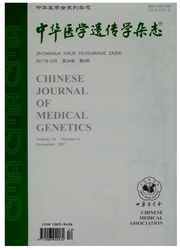

 中文摘要:
中文摘要:
目的明确一个常染色体显性遗传并多指(趾)家系的致病基因突变,为产前诊断提供依据。方法对该家系成员进行详细的临床检查,确定肢端畸形的类型。通过系谱分析确定其遗传方式。采集家系成员外周血,提取基因组DNA。通过文献复习,选择与肢端发育异常有关的HOXD13作为候选基因进行突变检测。应用PCR扩增与Sanger测序,对患者进行突变检测。通过TA克隆及琼脂糖凝胶电泳进一步验证突变。结果分析家系图谱与临床特征,确定该家系为一常染色体显性遗传并多指(趾)家系。突变检测发现,家系患病成员HOXD13基因第1外显子内插入了27bp,从而导致其编码的多聚丙氨酸链中被插入了9个丙氨酸残基,而家系正常成员则无此突变。结论该常染色体显性遗传并多指(趾)家系的致病突变为HOXDj3基因多聚丙氨酸链的延展突变。
 英文摘要:
英文摘要:
Objective To detect potential mutation in a Chinese family affected with autosomal- dominant synpolydactyly and to provide the basis for prenatal diagnosis. Methods Inheritance pattern was determined by clinical examination and pedigree analysis. Blood samples were obtained from members of the family. Genomic DNA was extracted and sequenced following PCR amplification. Suspected mutation was confirmed by subclone sequencing and agarose gel electrophoresis. Results A 27 bp expansion mutation in exon 1 of HOXD13 was identified in all affected individuals from the family but not in unaffected members and normal controls. The mutation has caused insertion of 9 alanines in the polyalanine-expansion region of HOXD13 protein. Conclusion A polyalanine-expansion within the HOXD13 probably underlies the disease in this family.
 同期刊论文项目
同期刊论文项目
 同项目期刊论文
同项目期刊论文
 期刊信息
期刊信息
